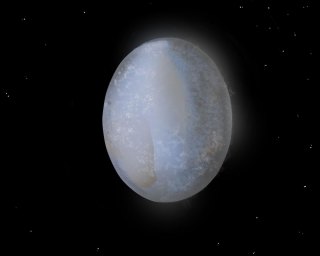
New research by theorists at the Harvard-Smithsonian Center for Astrophysics shows that scientists could spot the fingerprints of certain pollutants under ideal conditions. This would offer a new approach in the search for extraterrestrial intelligence.
Researchers believe the upcoming James Webb Space Telescope should be able to detect two kinds of chlorofluorocarbons -- ozone-destroying chemicals used in solvents and aerosols. The telescope could detect these chemicals if atmospheric levels were 10 times those on Earth. Ironically, a particularly advanced civilization might intentionally pollute the atmosphere to high levels and globally warm a planet that is otherwise too cold for life, according to the Harvard-Smithsonian Center.
The catch: The James Webb Space Telescope can only detect pollutants on an Earth-like planet circling a white dwarf star (what remains when a star like our sun dies). Finding pollution on an Earth-like planet orbiting a star like our sun would require an instrument more advanced than the Webb telescope -- a next-next-generation telescope.
Saturn moon's geysers: Even before we knew much about Saturn, it was always the exotic planet. But the more we know, the stranger it gets. Researchers say they have identified 101 distinct geysers erupting on Saturn’s icy moon Enceladus.
Using data from NASA’s Cassini spacecraft, scientists say their analysis suggests it is possible for liquid water to extend from the moon’s underground sea all the way to its surface.
The findings are presented in two articles published in the current online edition of the Astronomical Journal.
Over a period of almost seven years, Cassini’s cameras surveyed the south polar terrain of the small moon, a unique geological basin renowned for its four prominent "tiger stripe” fractures and the geysers of tiny icy particles and water vapor first sighted nearly 10 years ago. The result of the survey is a map of 101 geysers, each erupting from one of the tiger stripe fractures and the discovery that individual geysers are coincident with small hot spots. These relationships pointed the way to the geysers’ origin.
Rover holds record: NASA's Opportunity Mars rover has reached an odd milestone: It now holds the off-Earth roving distance record.
The rover landed on the red planet in 2004 and has rumbled around a total of 25 miles. The previous record was held by the Soviet Union's Lunokhod 2 rover.
This month's driving brought the rover southward along the western rim of Endeavour Crater. If the rover can continue to operate the distance of a marathon -- 26.2 miles -- it will approach the next major investigation site scientists have dubbed "Marathon Valley."
The Lunokhod 2 rover, a successor to the first Lunokhod mission in 1970, landed on Earth's moon on Jan. 15, 1973. It drove about 24.2 miles in less than five months, according to calculations recently made using images from NASA's Lunar Reconnaissance Orbiter cameras that reveal Lunokhod 2's tracks.
As Opportunity neared the mileage record earlier this year, the rover team chose the name Lunokhod 2 for a crater about 20 feet in diameter on the outer slope of Endeavour's rim on Mars.
The Mars Exploration Rover Project is one part of NASA's ongoing and future missions preparing for a human mission to the planet in the 2030s.
Sources: NASA and the Harvard-Smithsonian Center for Astrophysics.
Related:
A primer: Earth's 'cousin' orbits distant star
Ocean detected inside Saturn moon
NASA rover team to drill for clues about Mars